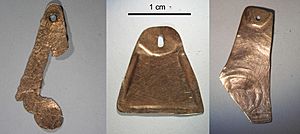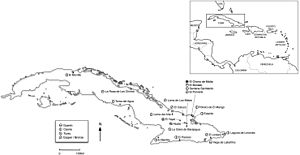Guanín facts for kids

Guanín is a special metal mix, or alloy, made from copper, gold, and silver. It looks a bit like red gold. People in ancient Central America used it a lot before Christopher Columbus arrived.
The name guanín comes from the language of the Taíno people. They really liked it because of its reddish color, bright shine, and unique smell. They believed it had special powers, both in the real world and in spiritual ways. It was also called taguagua, and in South America, it was known as tumbaga. The Spanish explorers called it "low gold" because it wasn't pure gold.
Guanín items have been found across central America. This shows that different cultures in the area traded and connected a lot. People used guanín to make many things, like human and animal statues using a method called lost-wax casting. They also hammered it into ceremonial medallions, which were also called guanín. For a long time, guanín was one of the most important items for trading over long distances in Central America and the Caribbean.
What is Guanín Made Of?
Guanín is a mix of copper, gold, and silver. In 1498, experts from Spain checked samples of guanín that Christopher Columbus sent them. They found it was about 56% gold, 18% silver, and 25% copper. At first, explorers thought guanín was a natural metal mix. But today, we know that the high amount of copper means it had to be made by melting metals together at very high temperatures.
The Taíno people loved the bright shine of polished guanín. They believed that light and shiny objects had special spiritual energy. This energy was thought to bring "healing and good feelings." It was also linked to good harvests and high social status. The idea that light meant power was so strong that some chiefs were named after the material. For example, a Taíno chief named Behechio was called Tureywa Hobin, which meant "king as dazzling and heavenly as guanín."
The Taíno also thought the smell of guanín was important. It smelled like a plant they called taguagua, known for its strong scent. Some think this plant might be the gold-flowered guanina plant, known today as Senna occidentalis. When the Spanish brought brass to the Caribbean, the Taíno valued it. This was partly because brass smelled similar to guanín.
History of Guanín
Guanín has been used in the Caribbean since at least the 1st century. Some pieces found in the central Andes date back to that time. Sheets of guanín discovered in Puerto Rico have been dated to between 70 and 374 AD.
In 1498, during his third trip, Christopher Columbus heard stories from local people. His journal, written by Bartolomé de las Casas, says that "a black people" came to Hispaniola from the south. They had spear tips made of a metal they called guanín.
In 1501, a royal rule made it illegal to sell guanín in Hispaniola. In the 1520s, it was sometimes used as money when regular coins were hard to find.
How Guanín Was Used
The Taíno people mainly used guanín to make hammered ceremonial medallions. These medallions were also called guanín. They showed the social and political power of the cacique, or chief. These special objects were exchanged during important social events. This included marriages, alliances, and visits between important people. Giving guanín objects during marriage ceremonies was linked to old stories about gender, creation, and new beginnings for society.
Guanín was also used to decorate special guaiza masks.


